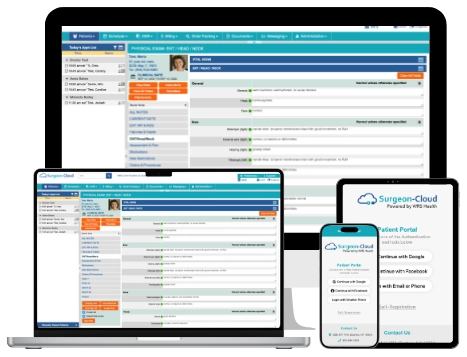Key Takeaways
- Shrinking reimbursements and soaring overhead create major financial strain for surgical practices.
- Outdated systems add administrative bloat that drains time and money.
- AI-enabled tools can reduce costs for surgery practices by streamlining tasks and preventing errors.
- Leverage Surgery-Cloud’s AI-enabled EHR to stay ahead in medical billing.
Table of Contents
The True Cost of Inefficiency In Surgery Practices
- Lost productivity as staff spend time on tasks that automation could handle.
- Billing errors and denials that leave revenue delayed or uncollected.
- Provider burnout that leads to turnover—and costly recruitment cycles.
When every minute and margin matters, invisible losses make it even harder to fight against rising healthcare costs for surgical practices.
The Cost of Staying with Legacy Systems
- Manual processes add labor costs. Without automation, every appointment scheduled and eligibility check requires staff time.
- Errors are more frequent. Missing payer details or incorrect codes lead to denials.
- Compliance risk grows. Outdated reporting tools can’t keep up with evolving regulations, increasing the chance of fines.
- Scalability suffers. Adding new surgeons or expanding locations multiplies inefficiencies, straining resources further.
How Can Surgical Practices Cut Costs Without Cutting Care?
The answer lies in tackling the practice’s administrative friction behind the scenes. Modern, AI-enabled systems streamline documentation, prevent billing errors, and automate repetitive workflows. These changes protect care by allowing clinicians to focus on patients, practice growth, and work-life balance instead of paperwork.
That’s where real cost reduction for surgery practices begins.
Smarter Workflows That Protect Revenue
AI-enabled tools transform the surgical practice EHR from a passive record-keeping system into an active cost-saving partner.
- Cleaner billing upfront: AI reviews claims before submission, flagging missing details and aligning codes with payer requirements to reduce denials.
- Automated scheduling and intake: Patients self-schedule, register, and verify insurance, lightening the load on front-desk staff and reducing overhead.
- AI-driven documentation support: Providers save time with context-aware charting that prompts for missing details and reduces after-hours work.
- Compliance safeguards: Built-in alerts help ensure reports meet payer and regulatory standards, reducing the risk of penalties.
Together, these features prevent costly mistakes and create efficiencies that directly support medical business profitability.
The Hidden ROI of Burnout Prevention
Surgical practices often focus narrowly on revenue and expenses without remembering that staff and provider wellbeing directly affect the bottom line. Burnout leads to turnover, which triggers expensive recruitment and onboarding. Productivity drops when staff feel overwhelmed by inefficient processes.
AI-driven automation reduces this burden. By offloading repetitive tasks and ensuring smoother workflows, practices keep their teams fresher, happier, and more engaged. In the long run, that stability has the potential to reduce costs as much as a reimbursement strategy.
Building a Cost-Resilient Surgical Practice
The rising cost environment isn’t going to change anytime soon. Overhead will continue to climb, and reimbursement is unlikely to improve dramatically. The difference between struggling and thriving will be whether practices adopt tools that maximize efficiency and minimize waste.
- Reduce revenue leakage from billing errors.
- Free staff from repetitive work with automation.
- Scale without multiplying overhead.
- Protect compliance and avoid fines.
- Preserve the energy and focus of their clinical teams.
Fight Back Against Rising Costs With Smarter Workflows
With AI-enabled tools, like Surgery-Cloud, practices can fight back against rising healthcare costs, rather than simply survive the cost crunch. The result is a leaner, more resilient business that can focus on what matters most: delivering excellent patient outcomes.











